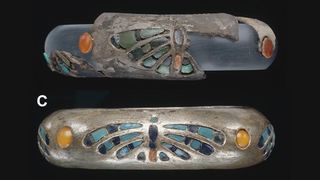Ancient Egyptian queen's bracelets contain 1st evidence of long-distance trade between Egypt and Greece
The silver used to make an ancient Egyptian queen's bracelets came from Greece, a new analysis finds, offering insight into the Old Kingdom's trade networks.

Bracelets found in the tomb of the ancient Egyptian queen Hetepheres I — the mother of Khufu, the pharaoh who commissioned the Great Pyramid of Giza — reveal new information about the trade networks that once linked the Old Kingdom to Greece.
After analyzing samples taken from the jewelry, an international team of archaeologists determined that the bracelets contained copper, gold and lead. There were also inlays made using semiprecious gemstones such as turquoise, lapis lazuli and carnelian, which were common features in ancient Egyptian jewelry, according to a statement.
However, the pieces, including one depicting a butterfly, also contained traces of silver, despite there not being any known local sources of the precious metal in ancient Egypt in 2600 B.C., when the items were crafted. The team looked at the ratio of isotopes — atoms that have different numbers of neutrons than usual in their nuclei — in the lead. Based on this analysis, the researchers determined that the materials were "consistent with ores from the Cyclades," a group of Greek islands in the Aegean Sea, as well as with those from Lavrion, a town in southern Greece, according to a study published in the June issue of the Journal of Archaeological Science: Reports.
Related: Long-lost jewelry from King Tut's tomb rediscovered a century later
"The origin of silver used for [artifacts] during the third millennium has remained a mystery until now," lead author Karin Sowada, a lecturer in the Department of History and Archaeology at Macquarie University in Sydney, said in the statement. "This new finding demonstrates, for the first time, the potential geographical extent of trade networks used by the Egyptian state during the early Old Kingdom at the height of the Pyramid-building age."
It's likely that the silver came through the port of Byblos in what is now Lebanon, said the researchers, who noted that Byblos tombs from the late fourth millennium have many silver objects and that there was activity between this port and Egypt at the time. The silver on the bracelets is the first evidence of long-distance exchange between Egypt and Greece, they added.
The study also provides insight into how the bracelets were forged.
Sign up for the Live Science daily newsletter now
Get the world’s most fascinating discoveries delivered straight to your inbox.
"The bracelets were made by hammering cold-worked metal with frequent annealing [a heating process] to prevent breakage," study co-author Damian Gore, a professor in the School of Natural Sciences at Macquarie University, said in the statement. "The bracelets were also likely to have been alloyed with gold to improve their appearance and ability to be shaped during manufacture."
Queen Hetepheres I was one of ancient Egypt's most influential queens; she was the wife of Sneferu, the first pharaoh of the fourth dynasty (circa 2575 B.C. to 2465 B.C.). Her tomb, discovered at Giza in 1925, held many treasures, such as gilded furniture, gold vessels and jewelry, including 20 of these bracelets, the researchers wrote in the study.
Some of the bracelets are currently part of the collection at the Museum of Fine Arts, Boston.
Jennifer Nalewicki is former Live Science staff wrtier and Salt Lake City-based journalist whose work has been featured in The New York Times, Smithsonian Magazine, Scientific American, Popular Mechanics and more. She covers several science topics from planet Earth to paleontology and archaeology to health and culture. Prior to freelancing, Jennifer held an Editor role at Time Inc. Jennifer has a bachelor's degree in Journalism from The University of Texas at Austin.
Most Popular

